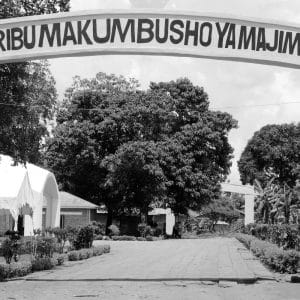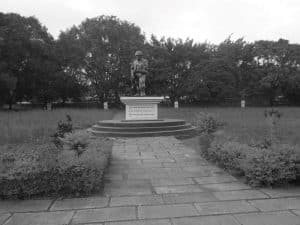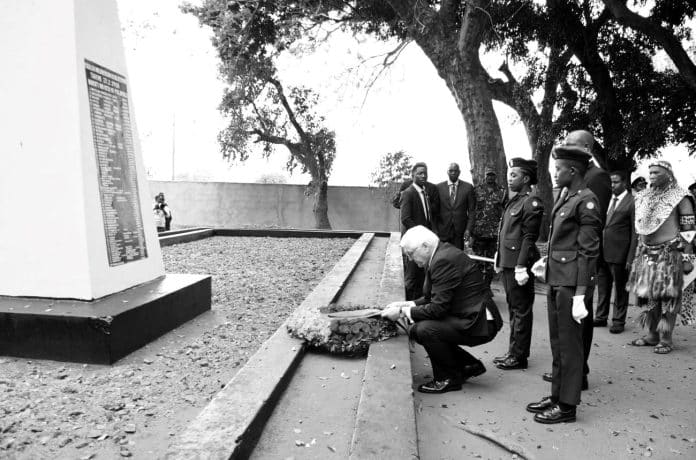Introduction to the Maji Maji Rebellion Museum
Nestled in the heart of Songea, Tanzania, the Maji Maji Rebellion Museum stands as a testament to the indomitable spirit of the Tanzanian people. This captivating institution invites you to embark on a journey through the annals of history, uncovering the remarkable story of the Maji Maji Rebellion – a pivotal moment that shaped the nation’s path to independence.
As you step through the museum’s doors, you’ll be greeted by a palpable sense of reverence and a deep-rooted commitment to preserving the memory of this significant event. The museum’s mission is to educate, inspire, and empower visitors, ensuring that the legacy of resistance lives on for generations to come.
The History of the Maji Maji Rebellion
The Maji Maji Rebellion was a widespread uprising that erupted in the early 20th century, challenging the colonial rule of German East Africa. In 1905, a local spiritual leader named Kinjikitile Ngwale rallied the diverse communities of the region, uniting them under the belief that a sacred water known as “Maji Maji” would protect them from the German’s bullets.
This powerful movement quickly gained momentum, with thousands of people from various ethnic groups joining the rebellion. The rebels, armed with traditional weapons and the belief in the Maji Maji’s invincibility, engaged in fierce battles against the well-equipped German colonial forces.
Despite the overwhelming odds, the Maji Maji Rebellion demonstrated the unwavering determination of the Tanzanian people to resist oppression and assert their right to self-determination. The conflict lasted for over two years, leaving a profound impact on the region and the course of Tanzanian history.
Significance of the Maji Maji Rebellion in Tanzanian History

The Maji Maji Rebellion holds a significant place in the annals of Tanzanian history. It was a pivotal moment that challenged the colonial power’s grip on the region and paved the way for the country’s eventual independence.
The rebellion’s legacy extends far beyond the military conflict itself. It served as a catalyst for the growing nationalist sentiment, inspiring future generations to continue the fight for freedom and self-governance. The Maji Maji Rebellion also highlighted the diverse cultural and ethnic tapestry of Tanzania, as people from various communities came together to resist the colonial rule.
Moreover, the rebellion’s impact can be seen in the subsequent political and social developments that shaped the country. The lessons learned from this historic event have continued to influence Tanzanian society, fostering a deep appreciation for the values of unity, resilience, and the unwavering pursuit of justice.
The Establishment of the Maji Maji Rebellion Museum in Songea
The Maji Maji Rebellion Museum was established in Songea, the epicenter of the historic uprising, to preserve and commemorate this pivotal moment in Tanzanian history. The museum’s creation was driven by the desire to ensure that the sacrifices and struggles of the Maji Maji rebels would never be forgotten.
Opened in 1995, the museum has since become a hub for education, research, and cultural preservation. It houses an impressive collection of artifacts, documents, and multimedia exhibits that bring the Maji Maji Rebellion to life, allowing visitors to immerse themselves in the rich tapestry of this historic event.
The museum’s strategic location in Songea, the heart of the rebellion, further enhances its significance. By being situated in the very place where the uprising began and unfolded, the museum offers a profound and authentic connection to the events that transpired, inviting visitors to walk in the footsteps of the Maji Maji rebels.
Exploring the Exhibits at the Maji Maji Rebellion Museum
As you step through the museum’s doors, you’ll be greeted by a captivating array of exhibits that transport you back in time. The museum’s carefully curated displays provide a comprehensive overview of the Maji Maji Rebellion, covering its historical context, key figures, and the pivotal events that unfolded.
One of the museum’s highlights is the impressive collection of traditional weapons and tools used by the rebel forces. These artifacts, meticulously preserved, offer a tangible connection to the determination and resourcefulness of the Maji Maji fighters. Alongside these relics, you’ll find informative panels and interactive displays that delve into the strategic and tactical aspects of the rebellion.
The museum also features a dedicated section that pays tribute to the spiritual and cultural dimensions of the Maji Maji movement. Here, you’ll learn about the role of Kinjikitile Ngwale, the spiritual leader whose rallying cry and belief in the Maji Maji’s protective powers inspired the masses to rise up against the colonial regime.
As you explore the museum’s exhibits, you’ll be captivated by the personal stories and testimonies of the Maji Maji rebels. These poignant accounts bring the historical narrative to life, allowing you to empathize with the struggles and sacrifices of those who fought for their freedom.
Learning about the Key Figures and Events of the Rebellion

At the heart of the Maji Maji Rebellion Museum’s exhibits are the stories of the key figures and pivotal events that shaped this historic uprising. Through interactive displays and immersive multimedia presentations, you’ll have the opportunity to delve into the lives and contributions of the rebellion’s most prominent leaders and participants.
One of the museum’s central figures is Kinjikitile Ngwale, the spiritual leader whose rallying cry and belief in the Maji Maji’s protective powers ignited the rebellion. You’ll learn about his spiritual practices, the rituals he performed, and the profound influence he had in uniting the diverse communities of the region.
The museum also shines a spotlight on the courageous Maji Maji rebels, whose unwavering determination and bravery in the face of overwhelming odds continue to inspire. You’ll explore the stories of individual fighters, their motivations, and the sacrifices they made in the pursuit of freedom.
Furthermore, the museum’s exhibits delve into the key events and battles that defined the Maji Maji Rebellion. From the initial uprising in Songea to the subsequent spread of the movement across the region, you’ll gain a comprehensive understanding of the rebellion’s trajectory and its impact on the colonial power.
Through these immersive experiences, you’ll come to appreciate the depth and complexity of the Maji Maji Rebellion, gaining a deeper understanding of its lasting significance in Tanzanian history.
Interactive Experiences at the Museum
The Maji Maji Rebellion Museum goes beyond traditional museum exhibits, offering a range of interactive experiences that engage visitors on a deeper level. These interactive elements not only enhance the educational value of the museum but also create a lasting impression that inspires visitors to reflect on the legacy of the Maji Maji Rebellion.
One of the museum’s standout features is the virtual reality experience, which allows visitors to step into the shoes of a Maji Maji rebel. Through this immersive simulation, you’ll be transported to the heart of the rebellion, witnessing the battles, the rallying cries, and the determination of the people who fought for their freedom.
The museum also features interactive exhibits that invite visitors to participate in traditional Maji Maji rituals and practices. From learning about the significance of the Maji Maji water to engaging in traditional dances and music, these hands-on experiences foster a deeper appreciation for the cultural and spiritual dimensions of the rebellion.
Moreover, the museum’s educational programs, workshops, and guided tours provide opportunities for visitors to engage with experts, scholars, and local community members. These interactive sessions offer a platform for discussions, debates, and the exchange of knowledge, further enriching the museum experience.
By seamlessly blending historical information with immersive and interactive elements, the Maji Maji Rebellion Museum ensures that visitors leave with a profound understanding and appreciation for this pivotal moment in Tanzanian history.
Impact of the Maji Maji Rebellion on the Local Community
The Maji Maji Rebellion Museum’s impact extends far beyond its walls, resonating deeply within the local community of Songea and the surrounding regions. As the epicenter of the historic uprising, Songea has a deep-rooted connection to the Maji Maji Rebellion, and the museum plays a crucial role in preserving and honoring this legacy.
For the local community, the museum serves as a source of pride and identity. It is a place where the stories of their ancestors are celebrated, and the sacrifices made during the rebellion are acknowledged and revered. The museum’s educational programs and outreach initiatives have fostered a sense of belonging and cultural pride among the local population, empowering them to take ownership of their history.
Furthermore, the museum has become a hub for community engagement and cultural preservation. It hosts various cultural events, festivals, and workshops that celebrate the rich traditions and artistic expressions of the Maji Maji rebels. These initiatives not only preserve the region’s cultural heritage but also provide opportunities for the local community to engage with their past and share it with visitors.
The museum’s impact also extends to the local economy. As a major tourist attraction, the Maji Maji Rebellion Museum has become a significant driver of economic development in Songea. It has created employment opportunities, supported local businesses, and attracted visitors from around the world, contributing to the overall prosperity of the region.
By fostering a deep connection between the museum and the local community, the Maji Maji Rebellion Museum has become a testament to the enduring spirit of the Tanzanian people, a place where the legacy of resistance continues to inspire and empower generations to come.
Visitor Information and Tips for Visiting the Museum
The Maji Maji Rebellion Museum in Songea, Tanzania, is a must-visit destination for anyone interested in exploring the country’s rich history and cultural heritage. To make the most of your visit, here are some helpful tips and information:
Location and Hours: The museum is located in the heart of Songea, about a 10-minute drive from the city center. It is open from Tuesday to Sunday, with varying opening hours depending on the season. It’s recommended to check the museum’s website or contact them directly for the most up-to-date information on hours of operation.
Admission and Fees: The museum charges a small admission fee for visitors, which helps support its ongoing operations and preservation efforts. Discounted rates are available for students, seniors, and children. It’s advisable to check the current fee structure on the museum’s website or at the entrance.
Guided Tours: For a more enriching experience, consider joining one of the guided tours offered by the museum. These tours are led by knowledgeable docents who can provide in-depth information and insights about the Maji Maji Rebellion and the museum’s exhibits.
Photography and Accessibility: Photography is generally allowed within the museum, but it’s important to respect any restrictions or guidelines. The museum also strives to be accessible to visitors with disabilities, with ramps, elevators, and designated accessible areas.
Nearby Attractions: While you’re in Songea, consider exploring other nearby attractions that complement the Maji Maji Rebellion Museum experience. These may include historical sites, cultural landmarks, and natural wonders that offer a deeper understanding of Tanzania’s rich heritage.
Planning Your Visit: To make the most of your visit, it’s recommended to allocate at least 2-3 hours to explore the museum’s exhibits and interactive experiences thoroughly. Additionally, consider combining your visit with a trip to other nearby attractions or cultural events to create a well-rounded itinerary.
By keeping these tips in mind, you can ensure a memorable and enriching visit to the Maji Maji Rebellion Museum, where the legacy of resistance and the vibrant history of Tanzania come alive.
Conclusion: Reflecting on the Legacy of Resistance at the Maji Maji Rebellion Museum
As you step out of the Maji Maji Rebellion Museum, you can’t help but feel a renewed sense of appreciation for the enduring spirit of the Tanzanian people. This captivating institution has not only preserved the memory of a pivotal moment in history but has also ignited a flame of inspiration that continues to burn brightly.
The Maji Maji Rebellion Museum’s legacy extends far beyond its walls, serving as a testament to the power of resistance and the unwavering pursuit of freedom. Through its immersive exhibits, interactive experiences, and educational initiatives, the museum has become a beacon of hope, reminding us that even in the face of overwhelming odds, the human spirit can rise up and triumph.
As you reflect on the lessons learned from the Maji Maji Rebellion, we encourage you to visit the museum and immerse yourself in this captivating chapter of Tanzanian history. By doing so, you’ll not only gain a deeper understanding of the past but also find inspiration to shape a more just and equitable future. Plan your visit to the Maji Maji Rebellion Museum today and embark on a journey of discovery, empowerment, and the enduring legacy of resistance.
For more articles related to Cultural Institutions, click here!

































